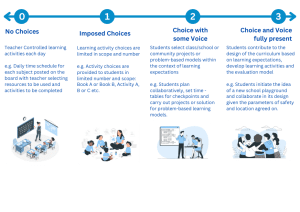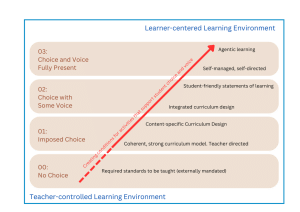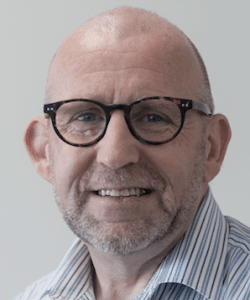Agency By Design: The Continuum of Choice
CompetencyWorks Blog
In today’s rapidly evolving educational landscape, fostering students’ engagement and connection to their learning is more critical than ever. Central to this endeavor is the concept of providing students with greater voice and choice in their educational journey. This approach not only empowers students but also transforms classrooms into dynamic, agentic environments where learners take an active role in their education. As educators, embracing this shift can revolutionize our teaching practices and significantly enhance student outcomes.
In the recently published resource, Agency by Design: An educators’ playbook, a chapter dedicated to student motivation and engagement invites us to examine our practice related to voice and choice for students. This resource suggests that creating the conditions for students to have a sense of self-determination in the choice of assignment, pacing and/or order of completion provides a starting point for developing the partnerships we desire with our students.
In the spirit of an ongoing conversation about what it means to authentically bring voice and choice to the classroom, this post invites us to “dig deeper” into what it means to give students voice and choice in their school experience.
A Provocative Question
The authors of “Agency by Design: an Educator’s Playbook,” recently spoke at the joint international Conference of The Educational Collaborative for International Schools (ECIS) and New England Association of Schools and Colleges (NEASC), held in Windsor, United Kingdom. We were fortunate to have many like-minded educators from across the world gathered in our session to focus on generating agentic behaviors with their students. During this session a provocative question came to the floor: “When is choice merely a different type of compliance exercise?”
Because we love provocative questions, it became apparent that this needed a “digging deeper” conversation.
The Continuum of Choice
As we reflected upon this question, we emphasized that the concept of voice and choice is not one-dimensional. We suggested that the elements found within the experiences being provided under the guise of voice and choice could best be understood as part of a continuum.
Creating an example from recent travel experiences seemed to provide an excellent starting point for this conversation. When sharing recent travels among the three of us, we found that there were very distinct types of experiences. All the examples of travel provided choices of sorts. But the idea of a continuum of choices became apparent when it came to how much flexibility and originality we had in what we “chose” to do.
The same can be said when sharing experiences for students as observed in lesson design. Not all voice and choice options fit into the same position on the continuum.
The sections illustrate how a continuum might be considered to show how this sort of progression may be thought of.
Example One: Family Vacation
First, let’s consider something many will be familiar with – taking a family vacation. There’s certainly no single way of this happening as illustrated on the continuum below. Besides the obvious differences in location and nature of the vacation, the key difference is the amount of choice those participating have about the destinations and activities they enjoy together.
 At the left hand end of the continuum the family has no choices to make as the vacation is organized as part of a family vacation trip itinerary purchased by parents. All the participants have to do is enjoy what’s been planned. At the right hand end of the continuum the participants are making choices at every stage of the journey, with factors such as weather, sights to see, and opportunities they meet along the way influencing their decisions.
At the left hand end of the continuum the family has no choices to make as the vacation is organized as part of a family vacation trip itinerary purchased by parents. All the participants have to do is enjoy what’s been planned. At the right hand end of the continuum the participants are making choices at every stage of the journey, with factors such as weather, sights to see, and opportunities they meet along the way influencing their decisions.
Example Two: Classroom Teaching and Learning
Now let’s apply that same continuum to what happens in the school or classroom context. In the continuum illustrated below you can see the same progression from no choices to choice and voice fully present using everyday examples from classroom practice.
 In this example the left hand end (no choices) represents the sort of classroom where everything is run to a schedule created by the teacher on behalf of the students. This includes everything from the timetable for the day to the specific titles used for reading or problems used in math, for example. At the other end of the continuum (choice and voice fully present) the ownership of learning is more in the hands of the students – operating within the parameters set out by the teacher.
In this example the left hand end (no choices) represents the sort of classroom where everything is run to a schedule created by the teacher on behalf of the students. This includes everything from the timetable for the day to the specific titles used for reading or problems used in math, for example. At the other end of the continuum (choice and voice fully present) the ownership of learning is more in the hands of the students – operating within the parameters set out by the teacher.
Let’s explore the stages on the continuum in a little more detail.
The Continuum Starts at “0” – No Choices Available
On the family vacation, for example, where the itinerary has been organized by the tour company, the experiences of the parents and children are all pre-determined. The activities for each day are planned, each meal is planned, and the “group” stays together throughout the journey. This creates a safe and manageable experience, and can be a thoroughly enjoyable option. But it can also feel limiting for some as participants don’t really have any real choice in what happens or how it happens.
At school, the scenario is similar: while considering the activity of the day, the teacher makes all the decisions, some of which may be mandated by the school or the district. Students are expected to comply with what is being asked of them. In the well-executed classroom, this can provide an enjoyable experience for many students, as all they have to do is follow the instructions and complete the assignments. Personal ownership of the work and the sense of partnership is absent or less likely to be found at this level on the continuum.
The Continuum Level 1: Imposed Choices
In the “imposed choice” level on the continuum, travelers and students have choices provided for them, but don’t have any input as to what those choices might be. A truly authentic level of engagement and ownership may be missing.
On a scenic river cruise in Europe, for example, travelers may be offered the opportunity to take day trips to cultural site A or cultural site B, for example – but not to site C, which may be of interest to some. No input is sought from the traveler about the nature of what is being offered – until the survey at the end of the tour asks your input for future changes.
At school, this may be where the curriculum is so controlled that students are given limited or no real choice about what they are learning, even if in some cases, they have already mastered a standard for a grade level, or where the work provided is below the grade level they have achieved. For example, they may be asked “Do you want to read book A or book B? Or do you want to write about topic 1 or topic 2?” Here students make a choice without voice as to whether any of the choices are meaningful or of interest. However, compliance by the students to the pre-set agenda in the well-ordered classroom is expected.
Some assignments might be a type of “leveled” choice. For example, students moving at an advanced pace may choose to do an applied activity while students who have not yet mastered the current skill may elect to work on a skill development assignment. Students choose the level of difficulty best suited to where they are on the learning progressions. In this example, the choices are limited to those provided by the teacher and unlike the travelers’ survey, the students may not be not asked for feedback on their likes or dislikes about the choices they were given.
In both cases here, the travelers and the students are given choice in a very controlled environment. In these cases there is no input from the travelers or the student.
The Continuum Level 2: Choice with Some Voice
With more self-determined travel, travelers have some say in the choices being offered. When a family takes a sailing trip together for example, the destination may be pre-determined, but everyone on the trip may contribute ideas as to which places they want to visit and how long they wish to stay at each stop. There is less planned itinerary and significant collective voice from the group.
In school, this could be found in project work, for example. Students know the expectations of the project, based on teacher-set expectations, and may also have the opportunity to choose who they work with. They collectively work to create the project, selecting how and what to bring forward because of their combined interests and expertise.
As with travelers on a sailing trip, students working on a project together have the big picture of what they want to accomplish, but are given a lot of freedom within the parameters of the learning outcomes. Voice and choice are enhanced through collective planning and implementation.
The travel goals, as well as the learning outcomes, are predetermined. But there is more flexibility in how the goals are met.
The Continuum Level 3: Choice and Voice Fully Present
At level 3 of the continuum is the opportunity to allow choice and voice to be fully exhibited. There is no pre-set agenda. Both the destination or outcome and the way of getting there are based on decisions made by the participants. There is creativity and flexibility to meet the expectations of each in a variety of ways. All decisions are left to the innovative and creative thinking of the participants.
Imagine setting out on a sailing journey with multiple destinations in mind. The group may make decisions based on personal preference, the weather on the day or a recommendation from another traveler. Each day the goal might be to meet the people, enjoy the cuisine, marvel at the beautiful scenery – but on a day-to-day basis accomplishing this goal is entirely in the hands of the participants.
The fully present voice and choice allows a sense of self-determination that is energizing and exciting – with a sense of self-discovery as well. The group is truly immersed in their experiences.
Transferring this to the school context, we might consider a learning experience where expectations are discussed collectively, and of course must embrace meaningful learning outcomes when associated with academic expectations. Students are able to structure how they intend to show mastery of the learning expectations or outcomes, and what experiences would support their learning. This is where authentic empowerment comes into play. Learners see themselves in the drivers’ seat of learning. Students will choose the evidence they will provide to show understanding of the concept, including a level or rigor which comes with deep learning. They can plan checkpoints along the way, using a calendar or tracking system to monitor their completion of the project. Time management, working well with others, and other skills which are necessary for life and work emerge when learners develop their agency at this level.
The teacher is an adaptor, mentor, guide, and checkpoint contact.
Community-based projects and problem-based learning are other excellent examples of level 3 experiences. In each case students engage in identifying a need, and then in creating a solution to the problem. The teacher/mentor advises students of pitfalls, laws, or other constraints as they consider their solution. But the solutions and the day-to-day progressions are in the hands of the students. It is important to note that almost every standard can be addressed through community-based or project-based learning opportunities, such as reading with meaning, writing to convey thought, problem-solving, working with others, task planning and completion, etc. Educators can look at the finished product and process to see the evidence of these integrated projects. In addition, learners become empowered and engaged within their community as change makers.
Concrete examples of this might include students generating a civics course of study within the context of the local government offices or the design of playground space at a new elementary school. In both examples, students find skillful use of their voice and make deliberate and functional choices about their work. In both examples, the activity enhances communication skills, along with other executive skills that are so desirable in responsible, contributing adults.
As we continue to enrich our understanding of a transformational classroom, it is particularly important to ask questions and think deeply about our work. The conversation stemming from the original provocative question should continue.
“When is choice merely another form of a compliance exercise?”
This question is very legitimate and deserves reflection. And, practically speaking, all the levels of the continuum will be in play in our learning environments, depending upon the specific conditions present. With that said, intentionality in lesson design is essential.
The image below provides a comprehensive way of identifying the amount of student choice you include as part of your learning design:

Building Towards a Learner-Centered Learning Environment
As we move our students into situations with more flexibility and creativity, it is helpful to remember that readiness is the result of experiences over time that build capacity. It would be a disservice to students and the teacher alike to place ill-prepared students in an activity on the continuum for which no one is prepared. It would be the same disservice to keep students who have the capacity to embrace flexibility and use creativity in an overly structured environment that inhibits them personally. In the latter case, students may be compliant but are most likely disaffected and may have little to no ownership of the activity.
The Agency by Design: Playbook provides significant support in thinking about how to integrate more choice and voice into the learning activities we design for our students. This free, downloadable resource will give you suggestions to create a more agentic learning environment where students can be engaged in more flexible and creative learning experiences. Level 3 continuum of choice experiences have the potential of adding enthusiasm and excitement to the lives of our students. Wouldn’t it be great if students came to school excited to be there and left inspired in anticipation of coming to school tomorrow!
Learn More
- Mindsets and Resources for Unleashing Learner Agency
- What Do You Mean When You Say “Student Agency”?
- 2024 Aurora Institute Field Survey: Strategies and Practices that Advance CBE
 Marsha Jones is an experienced educator with over 50 years of service. During Marsha’s tenure with the Springdale School District, exponential growth brought a tremendous increase in diversity and shifts in overall socio-economic status. It became readily apparent in order to realize the goal of “learning for all”, a fundamental shift in educational practices would be required, based on the concepts of personalizing learning, building on student assets and strengths, and developing student agency. Upon retiring, she is an avid author and continues to teach. She was the Associate Superintendent with the Springdale School District, Springdale, Arkansas. Currently, she is an adjunct professor at the University of Arkansas, teaching in the Arkansas Impact Fellows Program for aspiring administrators, funded by the Walton Family Foundation.
Marsha Jones is an experienced educator with over 50 years of service. During Marsha’s tenure with the Springdale School District, exponential growth brought a tremendous increase in diversity and shifts in overall socio-economic status. It became readily apparent in order to realize the goal of “learning for all”, a fundamental shift in educational practices would be required, based on the concepts of personalizing learning, building on student assets and strengths, and developing student agency. Upon retiring, she is an avid author and continues to teach. She was the Associate Superintendent with the Springdale School District, Springdale, Arkansas. Currently, she is an adjunct professor at the University of Arkansas, teaching in the Arkansas Impact Fellows Program for aspiring administrators, funded by the Walton Family Foundation.
 Annette Thompson is passionate about transforming education to improve educational opportunities for all learners. An elementary school teacher and principal for 37 years, she was named Arkansas Elementary Principal of the Year and an NAESP National Distinguished Principal in 2017. Currently, she is the Chief Executive Officer at Inquire Innovation. Annette can be reached at www.inquireinnovation.com.
Annette Thompson is passionate about transforming education to improve educational opportunities for all learners. An elementary school teacher and principal for 37 years, she was named Arkansas Elementary Principal of the Year and an NAESP National Distinguished Principal in 2017. Currently, she is the Chief Executive Officer at Inquire Innovation. Annette can be reached at www.inquireinnovation.com.
 Derek Wenmoth is regarded as one of education’s foremost future-focused thinkers. He works extensively with schools and systems in New Zealand (NZ) and elsewhere as they seek to prepare students for their future. He also consults with policymakers and government agencies regarding the future directions of NZ educational policy and practice. He is currently running FutureMakers, an educational consultancy focused on making our education system more future-focused by inspiring the next generation of leaders, thinkers, and problem-solvers.
Derek Wenmoth is regarded as one of education’s foremost future-focused thinkers. He works extensively with schools and systems in New Zealand (NZ) and elsewhere as they seek to prepare students for their future. He also consults with policymakers and government agencies regarding the future directions of NZ educational policy and practice. He is currently running FutureMakers, an educational consultancy focused on making our education system more future-focused by inspiring the next generation of leaders, thinkers, and problem-solvers.